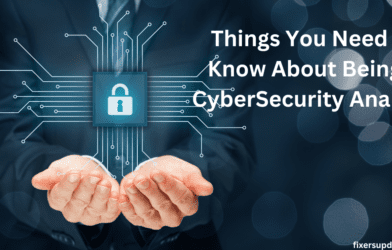Establishing successful cybersecurity KRIs
Ongoing Threat Landscape Visibility with the Evolution of Cyber Security threats, it is inevitable that new risks and vulnerabilities continually emerge as security systems and processes are established to combat them. Best Practices for Key Risk Indicators (KRIs) — One key to understanding how to monitor your security posture is through by developing effective key risk indicators, helping you detect weaknesses before they are attack vectors. Using such cybersecurity KRIs will allow you to better understand your risk landscape and develop plans to solidify protections against the threats. In this article, I am showing you how to create meaningful KRIs that fit the specifics of your organization. Learn how to identify the right metrics, set thresholds and use Key Risk Indicators (KRIs) to improve your decision-making and the effectiveness of your cybersecurity program.
Cybersecurity Key Risk Indicators (KRIs)
Cybersecurity KRIs (Key Risk Indicators) – These are the metrics being used by organizations to gauge and track probable cybersecurity risks. Such indicators represent the first alarm bell for businesses as to where security risks are taking hold, indicating problems which can be traced and corrected before they become major incidents.
Identify critical assets and processes
Find what matters most: Identify the critical assets and processes that your organization needs to run, and its reputation rests on.
Think about the impacts: Estimate the damage a cybersecurity incident could create on these assets and processes.
2. Define Risk Categories
Classify threats: Organize potential threats and group them into one of the following categories — Distinguish unauthorized access, Data breach, Malware or Denial-of-service attacks.
Identify major threats: Discover what leads to these liabilities, weak passwords, outdated software or lack of employee training.
3. Select Relevant Metrics
Use quantifiable metrics: Pick metrics that can be measured and tracked over time.
Compatible with risk categories – Make sure metrics align to the identified risk categories.
4. Establish Baselines
Performance Benchmarking: Define initial values for each KRI so you can gauge performance and detect variance.
Task 5 — Evaluate trends and benchmarks: You can benchmark your is metrics with the traditional industry statistics or historical data.
5. Monitor and Analyze
Monitor KRI performance: Continually check how your KRIs are performing and compare them to the agreed baselines.
Recognize Patterns and Exception: Identify trends or exceptions that show nascent risks.
6. Take Corrective Action
Respond to Outliers: When KRIs deviated from the baselines, swift corrective actions are taken to respond the risk.
Change KRIs as required: Periodically, you should review and revise your Key Risk Indicators in light of changes — in either the business or its risks.
Cybersecurity KRI Examples
Successful login attempts: This metric can be used to detect unauthorized access.
Patch percentage: This metric provides insight into how exposed the organization is to malware attacks.
Result: to measure your incident response Time to detect and respond ( lower is better) 6
Completeness of the training of employees in information security: it will help to control how well employee security training is carried out.
How are KRIs Significant for Cyber Risk Management?
KRIs: Key Risk Indicators (KRIs) are important in cyber-risk management, acting as an early warning system. The above set of metrics shed light on an organization’s security status which is very critical to promote proactive approach for the implemented risk mitigation strategies.
Enhanced Decision-Making
CyberSecurity Playbook — KRIs enables Cybersecurity teams to take data driven decisions. While watching these metrics can help organizations allocate resources more efficiently and better budget for ways to mitigate risk.
Improved Risk Visibility
Using KRIs together as build up a fuller picture of an organization’s risk landscape. That visibility makes it possible to communicate cyber risks in a way that you know stakeholders will understand and keep the entire company more secure.
Regulatory Compliance
Cybersecurity burdens are no distinction and a lot of enterprises must managed hard regulatory demands for security. KRIs serve as a way to help organizations prove compliance by demonstrating their efforts to manage risk in a tangible manner which is less expensive than simply paying the fines and reputational loss post-investigation.
Building Good KRIs For Your Organization
Map KRIs to Business Goals
The post Is Your Healthcare Program Too Comfortable with Cyber Risk? appeared first on HealthITSecurity. Make sure that the KRIs you use for your GRC program meaningfully contribute to these objectives, by highlighting possible threats and vulnerabilities.
Establish Specific Metrics and Limits
Define meaningful KRI metrics for each. Sensitively sets a range of alert thresholds that can trigger associated actions when breached. Review these thresholds at regular intervals and tune them with your risk landscape.
Continuously Monitor →
Create a powerful real-time data collection & analysis system Use automation to monitor KRIs on a regular basis throughout the organization for early warning signs of emerging risks and better informed decision making.
Cross-Functional Collaboration is Key
Involve stakeholders from multiple departments to obtain different points of view on possible risks. Through this collaboration, everyone has perspective and the entire organization is involved in security — helping to build a culture of shared accountability for cybersecurity.
How to Set Up and Measure Your Cybersecurity KRIs
Establish a Robust Framework
Well, first and foremost to start with a strong framework for your cybersecurity Key Risk Indicators (KRIs) in order to implement them successfully and keep an eye on these values. A general description and way of measuring each KRI should be defined with may thresholds being taken into account, as well as the appropriate methods to perform reporting duties. Be consistent with your corporate risk appetite and cyber security strategy
Automation and Analytics
Use automation Software & advance analytics to intake data continuously related to all your KRIs. It allows for threats to be monitored in real time and reacted to quickly. Use dashboards and alerts to deliver actionable information to stakeholders, enabling them to make decisions in a timely manner.
Regular Review and Refinement
Review your KRIs regularly to make sure that they are still working and appropriate. Always Have Classification at the Ready As threat landscapes change, so should your indicators. Feedback from the Various Departments: Keep your KRIs aligned to the Business Objectives and Risks which might be emerging,YOU can do this by encouraging feedback across Verticals.
Leveraging KRIs for Cybersecurity Continuous Improvement
Using Key Risk Indicators for a Strong Cybersecurity Posture By using KRIs you can find weaknesses, monitor your defense and take decisions with better data. Review and Update: Reviewing and updating are some practices you can follow to keep your KRIs relevant with technology changes.
Implementing a Feedback Loop
Create a well-defined feedback loop to build KRI data into your risk strategy. This process allows you to:
Tackle risks as and when it arises
Allocate Resources More Effectively
Develop security protocols in accordance with the latest info it receives
Create a culture of always trying to improve so that you can effectively anticipate threats and remain mostly proactive in how you handle cybersecurity. Goals are not limited to compliance, but for a versatile security posture that can handle digital changes.
How to Select Impactful KRIs
The selection of relevant Key Risk Indicators (KRIs) is maybe the most important aspect of a robust cybersecurity strategy. The key is to tie KRIs into broader business objectives and ensure they complement rather than detract from your organization’s overall risk profile. Emphasize signs that are worthwhile, ones with associative outcomes and highlights of potential threats in advance.
Leading as well as Lagging indicators need to balance
So, an ideal solution involves looking at both leading and lagging indicators when determining your security posture. Leading indicators Predict future risk, on the other hand, lagging indicators indicate what your current practices have achieved.
Prioritize KRIs
Choose quantitative, measurable and industry-specific KRIs applicable to your threat landscape Review them from time to time as your organization evolves and new threats arise upon you. Work with stakeholders across the department to identify key assets and processes that need monitoring
Top Three Best Practices for Implementing KRIs
Develop KRIs in Line with Strategic Objectives
KRIs must, therefore, be aligned with the business to focus depth attention on those things that can significantly impact your overall business goals.
Establish Clear Thresholds
Set thresholds for individual KRI above/below which action is taken. These thresholds need to reflect the organization’s appetite for risk and benchmark against industry norms.
Work with Your Warehouse Management Provider to Automate Data Capture and Reporting
Integrate your kri data with automation tools in real-time to detect threats sooner so you can act faster. Use dashboards and “standard” reporting for the benefit of keeping Horizon 1 stakeholder regularly updated.Identifying what stakeholders need in order to make a decision is the jumping-off point.
Best Practices in Measuring and Monitoring KRIs
In practice, this means continuously assess the performance of your Key Risk Indicators (KRIs) for cybersecurity to keep them effective. Each KRI is then assigned with benchmarks and thresholds clearly defined. Create a sustainable data processing and analysis system while using automated processes to make reporting that much easier.
Keep reviewing your KRIs on a regular basis and update them as per the relevance or accuracy. Continuously assess how closely they line up with your risk management approach.
If a KRI repeatedly shows zero effect in being able to mobilize any form of change, re-evaluate on how useful they are or else bolt them down again with the right parameters.
IRP_A_Defining_and_Improving_Cyber_Defenses_using_KRIs [PROCESS]
Iterative Improvement Process
Cycle Your Improvements in cyber Security:
Regularly assessing KRI data
Trend and anomaly detection
Ranking elements for development
Adding Granular Security
Measuring the Effect of the Changes
This will allow you to have the most agile, response and future-proof cybersecurity strategy.
Challenges to Implementing KRIs for Cybersecurity
KRIs offer many advantages, of course — but they also present challenges in the difficulty with their implementation. What obstacles are often encountered?
1. Data Availability
Vulnerable to data inconsistencies; KRI is only as relevant as the accuracy and timeliness of data supporting it. Pulling data at the interval convenient to investigate your tenant could lead to a false sense of visibility or adverse conditions as some data will export incomplete and/or inconsistent.
2. Resource Constraints
To monitor Key Risk Indicators, resources including people and technology are needed. This is easier said than done, especially for smaller organizations.
3. Defining the Right Metrics
Individual stocks are incredibly risky, but because we assume the best use of owning an individual stock is finding it undervalued at purchase and then selling it later for a profit when priced accordingly (moderate risk investing strategy), should their KRIs be any less intense than our own? Balance is key
4. Evolving Threat Landscape
With cyber threats changing constantly, this process alone must be reviewed on a regular basis.
Tip for Cybersecurity Key Risk Indicators Governance
What follows are some best practices on how to get the most value out of your cybersecurity Key Risk Indicators (KRIs).
Update KRIs Consistently:A changing threat landscape means constant evaluation of your KRIs will help you stay aheadInternalEnumerator_EXCEPTION_OCCURRED
Automate Monitoring—use security alerts and automation to automatically track KRI thresholds and alert, in real-time if a threshold is crossed.
Engaging Stakeholders — Make certain both your executive team and other stakeholders can speak to the health of the company’s KRIs and risk posture by providing timely metrics that accurately represent your desired outputs.
Mapping KRIs with Governance: Other than integrating the concept, KRIs should be mapped with your governance framework to make sure compliance as per industry standard or regulation is monitored.
Conclusion
Keep in mind that the onboarding of cyber security key risk Indicators at your Organization is a process; it requires consistent tuning and review over time. Selecting, measuring and monitoring the right KRIs will give you invaluable intelligence to better defend your firm against threats. Continue to be dynamic in changing your signals as the danger landscape changes. By implementing a comprehensive list of cybersecurity KRIs on an ongoing basis, you will be able to make decisions based on solid data that helps you effectively deploy resources and truly bolster your security program. Adopting this methodology represents a key step in protecting the digital assets of your business and, in turn, maintaining the trust of all stakeholders in an increasingly complex cyber landscape.
ANSWERS TO YOUR 4 QUESTIONS
What is a key risk indicator in cybersecurity?
In cybersecurity, a measurable value that will help to assess potential risks endangering an enterprise’s security posture is called Key Risk Indicator (KRI). KRIs are used to foresee threats by 9 warning signals of weakness or external risks, such as malware that can launch a zero-day exploit, data breaches, insider attacks etc.
How do you develop key risk indicators?
A good guide to developing KRIs includes identifying critical assets, assessing known and potential cyber threats to those assets, and using that data to set metrics which approximate weaknesses. Monitoring KRIs at a predefined interval and mapping them to the organization’s risk appetite and cybersecurity strategy keep them updated and useable.
What is a KPI in cybersecurity?
In cybersecurity, a Key Performance Indicator (KPI) is something used to quantify how well security controls and incidents are being managed – i.e. KPIs indicate the performance of these secure practices. Summary: KPIs are operational metrics that enable organisations to determine just how secure they actually are.
What are key indicators of risks?
Some key signs that can indicate risks include strange network activity, growth in system vulnerabilities, a rise of phishing tries or numerous failed login attempts. This will show where the real risk is building and what needs to be done to prevent attacks of cyber security breaches before they can occur.














